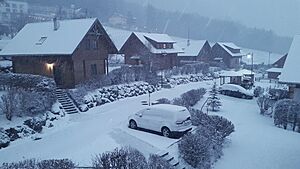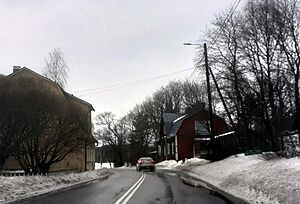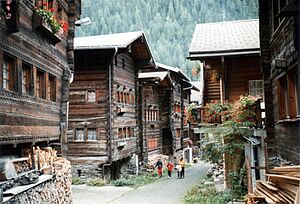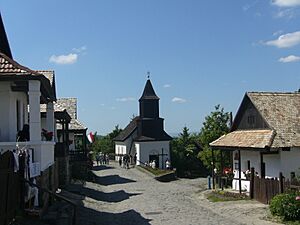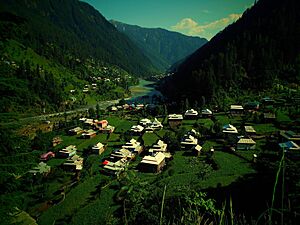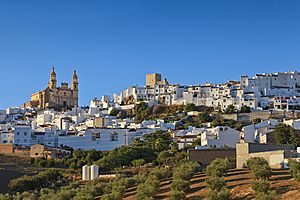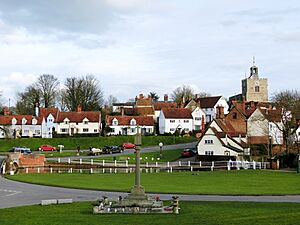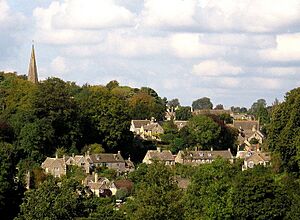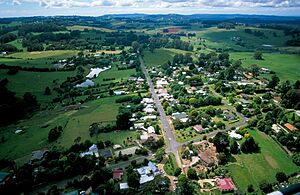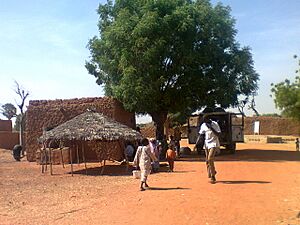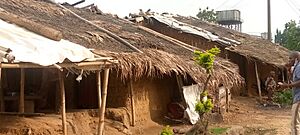Village facts for kids

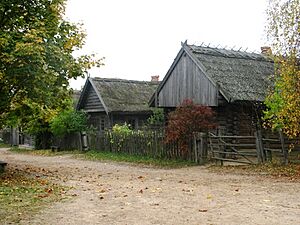
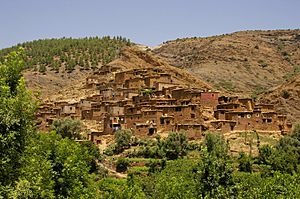
A village is a group of houses and buildings where people live together. It's usually bigger than a hamlet but smaller than a town. Villages often have a population from a few hundred to a few thousand people. Even though most villages are in the countryside, some city areas are called "urban villages." Villages are usually permanent, meaning people live there all the time in fixed homes. The houses in a village are generally close to each other, not spread out far apart.
In the past, villages were a common way for people to live, especially for those who farmed to feed themselves. In places like Great Britain, a hamlet became a village when it built a church. For a long time, most people lived in villages, with only a few living in towns or cities. The Industrial Revolution changed this. Many people moved to work in factories, causing villages to grow into towns and cities. This also led to people specializing in different jobs and crafts. The trend of people moving to cities continues today. Historically, homes were built close together for safety and to be social. The land around the homes was used for farming. Some villages were also built by the sea for artisan fishing.
Contents
What's in a Village Name?
The special names of individual villages are called Comonyms. This word comes from ancient Greek words meaning "village" and "name."
Where the Word "Village" Comes From
The word "village" comes from the Middle English word village. This word came from the Old French village, which finally came from the Latin word villa.
Villages Around the World
Villages look different and have different roles depending on where they are in the world. Let's explore some examples!
Villages in Asia
Many people in Asia live in villages. These communities are very important to their countries.
India's Villages

Mahatma Gandhi once said, "The soul of India lives in its villages." This means villages are very important to India's culture and way of life. In 2011, about 69% of Indians, which is around 833 million people, lived in villages. India has over 649,000 villages. Their sizes vary a lot. Some have fewer than 500 people, while nearly 4,000 villages have over 10,000 people! Most villages have their own temple, mosque, or church. This depends on the main religion of the people living there.
Pakistani Villages
Most people in Pakistan live in rural areas. About 64% of Pakistan's population lived in villages in 2017. Many rural areas in Pakistan are close to cities. A village is called deh or gaaon in Urdu. Life in Pakistani villages often focuses on family and community connections.
Villages in Southeast Asia
Southeast Asia has many unique villages. They often have special names and traditions.
Brunei's Villages
In Brunei, villages are the smallest official areas. They are called kampung in the Malay language. These can be traditional villages or modern living areas. A village is led by a ketua kampung, which means village head. Villages often have a primary school, a religious school, a mosque, and a community center.
Indonesian Villages
In Indonesia, villages are called kampung or desa. A desa follows old traditions and laws, while a kelurahan is more modern. Desa are usually in the countryside, and kelurahan are in cities. A village head is called kepala desa or lurah. Both are chosen by the local people. Villages are part of a larger area called a kecamatan, which is like a district.
Malaysian and Singaporean Villages
The word kampung is also used in Malaysia and Singapore. It means a Malay village or hamlet. In Malaysia, a kampung has 10,000 people or fewer. Historically, each Malay village had a leader called a penghulu, or village chief. Malay villages often have a mosque, rice fields, and houses built on stilts. People in these villages often help each other, a tradition called gotong royong. They value family, politeness, and belief in God.
Most kampung villages in Singapore are gone due to modern development. Only a few remain on small islands or in one last spot on the mainland, like Kampong Lorong Buangkok.
Vietnamese Villages
In Vietnam, a village is called "làng." Villages are very important to Vietnamese society. A typical Vietnamese village has a gate, bamboo hedges, a communal house for worship, a shared well, rice fields, a temple, and family homes. People in Vietnamese villages often have family ties. They are usually farmers who grow rice and practice traditional crafts. A Vietnamese saying, "Phép vua thua lệ làng," means "the king's law yields to village customs." This shows how important village traditions are. Many Vietnamese people want to be buried in their home village when they die.
Villages in Europe
Europe has many different types of villages, from old farming communities to modern residential areas.
Slavic Villages

Selo is a Slavic word for "village" used in countries like Bulgaria, Russia, and Ukraine. For example, many villages are named Novo Selo, meaning "New Village." Another Slavic word for village is ves. In Slovenia, selo is for very small villages, while vas is used more widely.
Bulgarian Villages
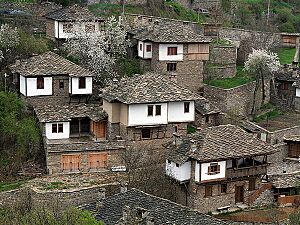
In Bulgaria, villages vary in size from 5-30 families to several thousand people. In 2002, about 2.3 million Bulgarians lived in villages. Many people enjoy "village tourism" in Bulgaria. They visit villages to experience the culture, crafts, friendly people, and beautiful nature.
Russian Villages

In Russia, about 26% of people live in rural areas. The two main types of villages are derevnya and selo. Historically, a selo had a church, while a derevnya did not. In the past, the government encouraged people to move from small villages to larger farms or towns. Most people in Russian villages work in farming and often grow their own food. Some city people buy village houses as second homes, turning villages into places for seasonal living.
Cossack regions in Southern Russia had a different setup. Families often lived on their own farms called khutor. Several khutors and a main village formed an area called a stanitsa. These stanitsas were often larger than typical villages in central Russia.
Ukrainian Villages
In Ukraine, a village, or selo, is the smallest administrative unit. Villages are managed by a local government called a hromada. There is also a smaller type of rural place called a selyshche, which means "settlement." In the past, there were also very small farms called khutir. These were individual farms with only a few houses.
French Villages
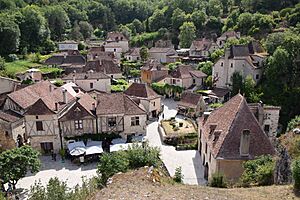
In France, villages are called communes rurales. These are communities with low or very low population density. There's a group called "The Most Beautiful Villages in France" that helps promote small, pretty villages with important history and culture. As of 2023, 172 villages are on this special list.
German Villages
In Germany, a Dorf (village) can have a few houses or up to a few thousand people. Larger villages might be called Flecken or Markt if they have market rights. Smaller villages usually don't have their own government. Instead, they are part of a nearby town's municipality.
Italian Villages

In Italy, there's no exact legal definition for a village. But usually, a place with fewer than 2,000 people is called a village. Villages that are part of a larger municipality are often called frazione. There's also an organization called "The Most Beautiful Villages of Italy." It works to protect and bring life back to small, historic villages. Its motto is "The charm of hidden Italy." As of 2023, 361 villages are on this list.
Spanish Villages
In Spain, a village is called a pueblo. It's a small group of people, smaller than a town or city, and usually in the countryside. There isn't a clear rule to tell villages, towns, and cities apart. They were traditionally grouped by their religious importance and how they related to other nearby places.
UK Villages

In the United Kingdom, a village is a group of houses, smaller than a town. They were often based on farming, mining, or fishing. Villages in the UK are similar to those in Ireland. The main things that shaped villages were where water was, how farming was organized, and if there was a risk of flooding. For example, villages in the Lincolnshire Wolds are often found along spring lines on hillsides.

Some villages have disappeared over time, leaving only old churches or bumps in fields. Others have grown and joined with nearby towns, becoming part of bigger suburbs. Many villages today are "dormitory" places, meaning people live there but travel to cities for work. They might have lost their shops, churches, and other services.
For many British people, the village is an ideal place. It's seen as quiet, peaceful, and away from busy modern life. This idea of a perfect countryside is shown in many popular stories and TV shows.
In the UK, the main difference between a hamlet and a village used to be that a village had a church. A typical village also had a pub, shops, and a blacksmith. But many of these are now gone. Villages are different from towns because:
- Villages usually don't have a regular market.
- Villages don't have a town hall or a mayor.
- If a village has a local government, it's called a parish council, not a town or city council.
- There should be clear open fields or a "green belt" around a village.
Villages in the Middle East
The Middle East has many villages, some of them very old and historically important.
Lebanese Villages
In Lebanon, villages are often found in remote mountain areas. Many Lebanese villages have names that come from the ancient Aramaic language. This is because Aramaic was spoken in Mount Lebanon until the 1700s. Lebanese villages are part of larger areas called "kadaa," which are like districts.
Syrian Villages
Syria has many villages that vary in size and importance. Some are ancient, historical, or religious, like Ma'loula. The different environments in Syria mean villages have different economic activities. Villages in the south, northeast, and near the Orontes River mainly rely on farming. Villages near Damascus and Aleppo focus on trading. Some villages, like Marmarita, are popular for tourism.
Villages in Oceania
Villages in Oceania have their own unique characteristics, often linked to island life.
Pacific Islands Villages
People from English-speaking countries who traveled to the Pacific Islands often called the local communities "villages." Some places, like several Villages of Guam, are still called villages even though they have large populations, sometimes over 40,000 people.
Australian Villages
In Australia, the word "village" is often used for small planned communities. These include retirement communities, shopping areas, or tourist spots like ski resorts. Small rural communities are usually called "townships." Larger places are called "towns."
Villages in North America
The idea of a village in North America is different from older parts of the world.
Canadian Villages
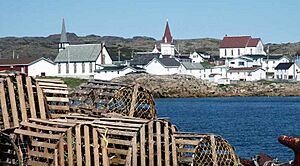
Some people believe the name Canada might come from an Iroquois word for "village." When Jacques Cartier explored, he was shown the "Kanata" of Kebec, and this word eventually became the name of the country.
United States Villages
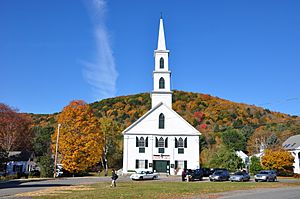
In many U.S. states, "village" means a specific type of local government. It's similar to a city but might have less power or cover a smaller area. However, some villages are much larger than the smallest cities in a state. The difference isn't always about population. It's more about the powers given to different types of local governments.
In states like New York and Michigan, a village is a town or township that has its own local government. Some villages can even cross county lines. There's no population limit for villages in New York. Hempstead, the largest village, has 55,000 people, which is more than some cities in the state.
In many states, "village" is also used informally to describe a small community that doesn't have its own government. This is similar to a hamlet.
Villages in Africa
Villages in Africa show great variety due to different cultures and environments.
Nigerian Villages
Villages in Nigeria are very different depending on the culture and geography.
Northern Nigeria Villages
In the North, villages were led by traditional rulers for a long time. After a holy war in 1804, the political system became Islamic. Emirs were the leaders, and they appointed people to help them, including village heads called Magaji. The Magaji reported to a Hakimi, who was like a mayor. The Magaji also had helpers called Mai-Unguwa, or Ward Heads.
Even though the Nigerian constitution doesn't officially recognize traditional rulers, they are still respected. Political leaders often work with them to reach the people. In the Hausa language, a village is called ƙauye. Many villages in the North are getting electricity and mobile phone service.
Southern Nigeria Villages
In Southeastern Nigeria, people lived in groups of huts belonging to family lines. In the Igbo language, villages are called ime obodo, meaning "inside town." A large village might have a few thousand people who shared the same market, meeting place, and beliefs.
South African Villages
In South Africa, most people in rural areas live in villages. Their populations can range from less than 500 to about 1,000 people.
Error: no page names specified (help).
Images for kids
See also
 In Spanish: Pueblo (población rural) para niños
In Spanish: Pueblo (población rural) para niños


